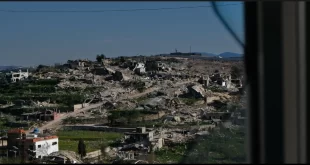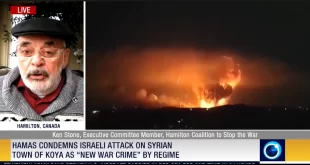June 19, 2017, Counter Punch – Mike Whitney
“Washington’s strategic objectives in Iraq and Syria are not those of “fighting terrorism,” but rather consolidating US hegemony over the oil-rich Middle East and preparing for war against the principal obstacles to this objective, Iran and Russia. For US imperialism, undisputed control over both the Persian Gulf and Central Asia would provide the means to cut off energy supplies to its global rival, China.”
— Bill Van Auken, World Socialist Web Site
On June 10, the Syrian Army blitzed across an arid stretch of countryside in southeastern Syria to reach the Iraqi border for the first time in three years. The move, which caught US war-planners off guard, prevents US-backed rebels from moving north from al Tanf to join the fight against ISIS in Raqqa and Deir Ezzor. More important, the move makes it impossible for Washington to achieve its broader strategic objective of consolidating its territorial gains into a contiguous landmass along the Euphrates River. Washington wants to control the eastern part of the country so it can continue its attacks on the regime while overseeing the construction of gas pipelines from Qatar to Turkey. The prospects of that plan succeeding are now greatly in doubt due to the surprise advance of the SAA.
Aside from the humiliation of being caught flat-footed by a Syrian Army that has been battered by 6 consecutive years of war, Washington has allowed loyalist troops to seize a swath of land that splits US proxies on the ground and establishes a critical land corridor connecting Damascus to Baghdad to Tehran, a Shia superhighway that allows for the transport of commercial goods, people and weapons from east to west. Washington wanted to avoid that linkage at all cost, but simply wasn’t prepared to respond. Now any attempt to reverse the situation will involve crossing SAA lines which increases the probability of a direct confrontation with Russia. This is why it is essential to pay attention to events on the ground as they take place. The US and Russia are basically cheek-to-jowl on a topsy-turvy battlefield where any miscalculation could have grave consequences.
This latest move by the Syria Army has only added to Washington’s frustration. Ever since Russian President Vladimir Putin announced the creation of four “de-escalation zones” on May 5, the so called Axis of Resistance (Russia, Syria, Iran and Hezbollah) has been marching eastward along three parallel tracks with the clear intention of liberating cities captured by ISIS and reestablishing Syria’s sovereign borders. It’s been a hard-fought slog, but the progress has been steady and ISIS has been pushed back or beaten wherever they’ve been met.
At the present pace, the fight against ISIS could be over in a matter of months, but that doesn’t mean the hostilities will end. No one really knows whether the Turks, the Kurds or the US-backed militias will agree to withdraw from the territories they’ve captured during the war, but the general consensus seems to be that they won’t. In fact, the US has actually accelerated its operations in order to grab as much land as possible before ISIS is defeated. Here’s a clip from an article in the New York Times that helps to explain what’s going on:
“American-backed forces have begun an assault on Raqqa, the Islamic State’s hub in northern Syria, and signs are that they could capture the long-sought target with relative ease. Yet the militant group’s commanders, who have already withdrawn their toughest forces from the city, and most everyone else in Syria’s multifaceted war are looking ahead to an even more decisive battle in the south.
There, a complex confrontation is unfolding, with far more geopolitical import and risk. The Islamic State is expected to make its last stand not in Raqqa but in an area that encompasses the borders with Iraq and Jordan and much of Syria’s modest oil reserves, making it important in stabilizing Syria and influencing its neighboring countries.
Whoever lays claim to the sparsely populated area in this 21st-century version of the Great Game not only will take credit for seizing what is likely to be the Islamic State’s last patch of a territorial caliphate in Syria, but also will play an important role in determining Syria’s future and the postwar dynamics of the region.
With the stakes so high, the United States, Iran and Russia are all scrambling for advantage. They are building up their forces and proxy fighters and, increasingly, engaging in inflammatory clashes that threaten to escalate into a larger conflict…..
What is really at stake are even larger issues. Will the Syrian government re-establish control of the country all the way to its eastern borders? Will the desert straddling the Syrian-Iraqi border remain a no man’s land ripe for militant control? If not, who will dominate there — forces aligned with Iran, Russia or the United States? Which Syrian factions will wield the most influence?” (“Beyond Raqqa, an Even Bigger Battle to Defeat ISIS and Control Syria Looms”, New York Times)
Repeat: The outcome of the battle for east Syria will determine “the postwar dynamics of the region.”
So, Washington may have been caught flat footed, but it is prepared to make every effort to succeed in maintaining its regional hegemony. That said, the fighting ahead is likely to be more ferocious than ever.
Deir Ezzor is shaping up to be the decisive battle of the war. Washington needs the provincial capital to control the territory east of the Euphrates to establish military bases and create a launching pad for future attacks on the Assad government. The US also wants to control the eastern border with Iraq so the land route from Baghdad and Tehran is permanently blocked. But the US simply doesn’t have the military assets to win the war outright, which means the battlefield losses will continue to mount until government troops retake large sections of the border and the main population centers in the east. This isn’t a war the US can win without putting more boots on the ground. (some say 150,000 are needed) But, as yet, there’s no sign that the Pentagon Brass is willing to do that.
At present, all of the warring parties are racing to seize as much land as possible. In some respects, that’s a positive development because it suggests that everyone thinks the war may be coming to an end so they’re positioning their armies in a way that best favors their territorial claims. But resolving the territorial issues won’t alone bring peace. There are deeper issues that can’t be resolved by merely granting greater autonomy to the Kurds, or allowing the Turks to maintain a “safe zone” in the northwest, or letting local (mainly Sunni) councils settle their own affairs in cities like Raqqa. For example, neither Putin nor Assad will ever agree to a deal in which Washington establishes a base in the east where it harbors and deploys jihadists back into Syria-proper to wreak havoc, terrorize the public, and threaten the central government. That’s not going to happen. So while Putin may be flexible about Syria’s borders or greater regional autonomy, he’s not going to give ground on the fundamental issues of national security or terrorism. Those are non negotiable.
Any peace deal is going to require give and take. No one is going to get everything they want. Washington will have to abandon its plan of annexing all the territory east of the Euphrates and Assad will have to accept a smaller sovereign Syria than the one that existed before the war broke out. All parties will have to lower their expectations. The problem is that Washington won’t accept a half-loaf solution because it remains committed to its goal of breaking up Syria, removing Assad, and controlling the vital resources in the Middle East in order to maintain its global primacy.
It’s going to take time and patience to discourage Washington’s aggressive behavior. There’s no easy fix. The resistance must be firm but flexible. Their national interests must be defended, but a broader war must be avoided. Washington must be gradually acclimated to the idea that it no longer rules the world, that its interests aren’t served by its erratic and destabilizing foreign policy, and that it must comply with international law.
Nudging the United States in the direction of a multipolar world in which its own narrow interests are not paramount, is going to take time. But what other choice is there; World War 3?
Let’s hope not.
 Syria Support Movement solidarity with the Syrian people
Syria Support Movement solidarity with the Syrian people




